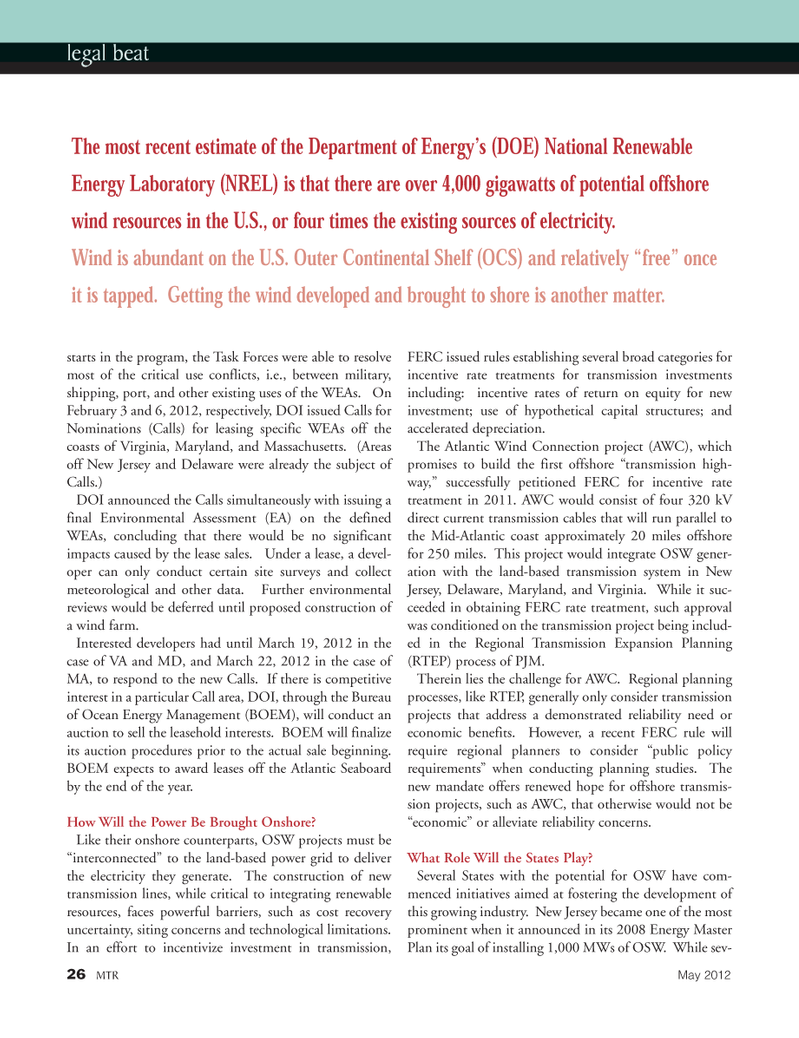
Page 26: of Marine Technology Magazine (May 2012)
Hydrographic Survey
Read this page in Pdf, Flash or Html5 edition of May 2012 Marine Technology Magazine
starts in the program, the Task Forces were able to resolve most of the critical use conflicts, i.e., between military, shipping, port, and other existing uses of the WEAs. On February 3 and 6, 2012, respectively, DOI issued Calls for Nominations (Calls) for leasing specific WEAs off the coasts of Virginia, Maryland, and Massachusetts. (Areas off New Jersey and Delaware were already the subject of Calls.) DOI announced the Calls simultaneously with issuing afinal Environmental Assessment (EA) on the defined WEAs, concluding that there would be no significant impacts caused by the lease sales. Under a lease, a devel- oper can only conduct certain site surveys and collect meteorological and other data. Further environmental reviews would be deferred until proposed construction of a wind farm. Interested developers had until March 19, 2012 in the case of VA and MD, and March 22, 2012 in the case of MA, to respond to the new Calls. If there is competitive interest in a particular Call area, DOI, through the Bureau of Ocean Energy Management (BOEM), will conduct an auction to sell the leasehold interests. BOEM will finalize its auction procedures prior to the actual sale beginning. BOEM expects to award leases off the Atlantic Seaboard by the end of the year. How Will the Power Be Brought Onshore? Like their onshore counterparts, OSW projects must be ?interconnected? to the land-based power grid to deliver the electricity they generate. The construction of new transmission lines, while critical to integrating renewable resources, faces powerful barriers, such as cost recovery uncertainty, siting concerns and technological limitations. In an effort to incentivize investment in transmission, FERC issued rules establishing several broad categories for incentive rate treatments for transmission investments including: incentive rates of return on equity for new investment; use of hypothetical capital structures; and accelerated depreciation. The Atlantic Wind Connection project (AWC), which promises to build the first offshore ?transmission high- way,? successfully petitioned FERC for incentive rate treatment in 2011. AWC would consist of four 320 kV direct current transmission cables that will run parallel to the Mid-Atlantic coast approximately 20 miles offshore for 250 miles. This project would integrate OSW gener- ation with the land-based transmission system in New Jersey, Delaware, Maryland, and Virginia. While it suc- ceeded in obtaining FERC rate treatment, such approval was conditioned on the transmission project being includ- ed in the Regional Transmission Expansion Planning (RTEP) process of PJM. Therein lies the challenge for AWC. Regional planning processes, like RTEP, generally only consider transmission projects that address a demonstrated reliability need or economic benefits. However, a recent FERC rule will require regional planners to consider ?public policy requirements? when conducting planning studies. The new mandate offers renewed hope for offshore transmis- sion projects, such as AWC, that otherwise would not be ?economic? or alleviate reliability concerns. What Role Will the States Play? Several States with the potential for OSW have com- menced initiatives aimed at fostering the development of this growing industry. New Jersey became one of the most prominent when it announced in its 2008 Energy Master Plan its goal of installing 1,000 MWs of OSW. While sev- legal beat 26MTRMay 2012The most recent estimate of the Department of Energy?s (DOE) National Renewable Energy Laboratory (NREL) is that there are over 4,000 gigawatts of potential offshore wind resources in the U.S., or four times the existing sources of electricity. Wind is abundant on the U.S. Outer Continental Shelf (OCS) and relatively ?free? once it is tapped. Getting the wind developed and brought to shore is another matter. MTR#4 (18-33):MTR Layouts 4/27/2012 10:06 AM Page 26

 25
25

 27
27
